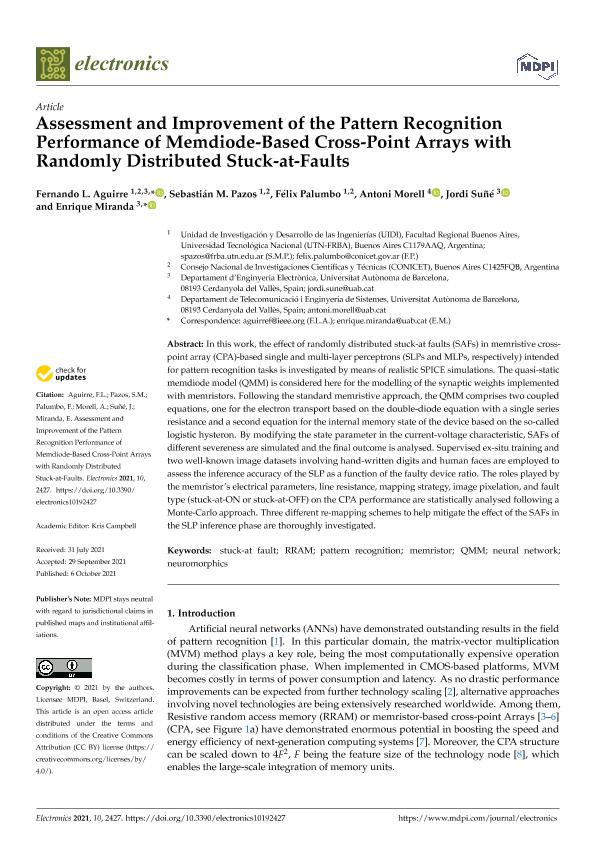Mostrar el registro sencillo del ítem
dc.contributor.author
Aguirre, Fernando Leonel

dc.contributor.author
Pazos, Sebastián Matías

dc.contributor.author
Palumbo, Félix Roberto Mario

dc.contributor.author
Morell, Antoni
dc.contributor.author
Suñé, Jordi
dc.contributor.author
Miranda, Enrique
dc.date.available
2022-04-13T15:02:20Z
dc.date.issued
2021-10-06
dc.identifier.citation
Aguirre, Fernando Leonel; Pazos, Sebastián Matías; Palumbo, Félix Roberto Mario; Morell, Antoni; Suñé, Jordi; et al.; Assessment and Improvement of the Pattern Recognition Performance of Memdiode-Based Cross-Point Arrays with Randomly Distributed Stuck-at-Faults; MDPI; Electronics; 10; 19; 6-10-2021; 1-24
dc.identifier.issn
2079-9292
dc.identifier.uri
http://hdl.handle.net/11336/155193
dc.description.abstract
In this work, the effect of randomly distributed stuck-at faults (SAFs) in memristive crosspoint array (CPA)-based single and multi-layer perceptrons (SLPs and MLPs, respectively) intended for pattern recognition tasks is investigated by means of realistic SPICE simulations. The quasi-static memdiode model (QMM) is considered here for the modelling of the synaptic weights implemented with memristors. Following the standard memristive approach, the QMM comprises two coupled equations, one for the electron transport based on the double-diode equation with a single series resistance and a second equation for the internal memory state of the device based on the so-called logistic hysteron. By modifying the state parameter in the current-voltage characteristic, SAFs of different severeness are simulated and the final outcome is analysed. Supervised ex-situ training and two well-known image datasets involving hand-written digits and human faces are employed to assess the inference accuracy of the SLP as a function of the faulty device ratio. The roles played by the memristor’s electrical parameters, line resistance, mapping strategy, image pixelation, and fault type (stuck-at-ON or stuck-at-OFF) on the CPA performance are statistically analysed following a Monte-Carlo approach. Three different re-mapping schemes to help mitigate the effect of the SAFs in the SLP inference phase are thoroughly investigated.In this work, the effect of randomly distributed stuck-at faults (SAFs) in memristive cross-point array (CPA)-based single and multi-layer perceptrons (SLPs and MLPs, respectively) intended for pattern recognition tasks is investigated by means of realistic SPICE simulations. The quasi-static memdiode model (QMM) is considered here for the modelling of the synaptic weights implemented with memristors. Following the standard memristive approach, the QMM comprises two coupled equations, one for the electron transport based on the double-diode equation with a single series resistance and a second equation for the internal memory state of the device based on the so-called logistic hysteron. By modifying the state parameter in the current-voltage characteristic, SAFs of different severeness are simulated and the final outcome is analysed. Supervised ex-situ training and two well-known image datasets involving hand-written digits and human faces are employed to assess the inference accuracy of the SLP as a function of the faulty device ratio. The roles played by the memristor?s electrical parameters, line resistance, mapping strategy, image pixelation, and fault type (stuck-at-ON or stuck-at-OFF) on the CPA performance are statistically analysed following a Monte-Carlo approach. Three different re-mapping schemes to help mitigate the effect of the SAFs in the SLP inference phase are thoroughly investigated.
dc.format
application/pdf
dc.language.iso
eng
dc.publisher
MDPI
dc.rights
info:eu-repo/semantics/openAccess
dc.rights.uri
https://creativecommons.org/licenses/by/2.5/ar/
dc.subject
STUCK-AT-FAULT
dc.subject
RRAM
dc.subject
PATTERN RECOGNITION
dc.subject
MEMRISTOR
dc.subject
QMM
dc.subject
NEURAL NETWORK
dc.subject
NEUROMORPHICS
dc.subject.classification
Nano-procesamiento

dc.subject.classification
Nanotecnología

dc.subject.classification
INGENIERÍAS Y TECNOLOGÍAS

dc.subject.classification
Ingeniería Eléctrica y Electrónica

dc.subject.classification
Ingeniería Eléctrica, Ingeniería Electrónica e Ingeniería de la Información

dc.subject.classification
INGENIERÍAS Y TECNOLOGÍAS

dc.title
Assessment and Improvement of the Pattern Recognition Performance of Memdiode-Based Cross-Point Arrays with Randomly Distributed Stuck-at-Faults
dc.type
info:eu-repo/semantics/article
dc.type
info:ar-repo/semantics/artículo
dc.type
info:eu-repo/semantics/publishedVersion
dc.date.updated
2022-04-07T21:04:04Z
dc.identifier.eissn
2079-9292
dc.journal.volume
10
dc.journal.number
19
dc.journal.pagination
1-24
dc.journal.pais
Suiza

dc.journal.ciudad
Basilea
dc.description.fil
Fil: Aguirre, Fernando Leonel. Universidad Tecnológica Nacional. Facultad Regional Buenos Aires. Unidad de Investigación y Desarrollo de las Ingenierías; Argentina. Universitat Autònoma de Barcelona; España. Consejo Nacional de Investigaciones Científicas y Técnicas; Argentina
dc.description.fil
Fil: Pazos, Sebastián Matías. Universidad Tecnológica Nacional. Facultad Regional Buenos Aires. Unidad de Investigación y Desarrollo de las Ingenierías; Argentina. Consejo Nacional de Investigaciones Científicas y Técnicas; Argentina
dc.description.fil
Fil: Palumbo, Félix Roberto Mario. Universidad Tecnológica Nacional. Facultad Regional Buenos Aires. Unidad de Investigación y Desarrollo de las Ingenierías; Argentina. Consejo Nacional de Investigaciones Científicas y Técnicas; Argentina
dc.description.fil
Fil: Morell, Antoni. Universitat Autònoma de Barcelona; España
dc.description.fil
Fil: Suñé, Jordi. Universitat Autònoma de Barcelona; España
dc.description.fil
Fil: Miranda, Enrique. Universitat Autònoma de Barcelona; España
dc.journal.title
Electronics
dc.relation.alternativeid
info:eu-repo/semantics/altIdentifier/url/https://www.mdpi.com/2079-9292/10/19/2427
dc.relation.alternativeid
info:eu-repo/semantics/altIdentifier/doi/http://dx.doi.org/10.3390/electronics10192427
Archivos asociados
